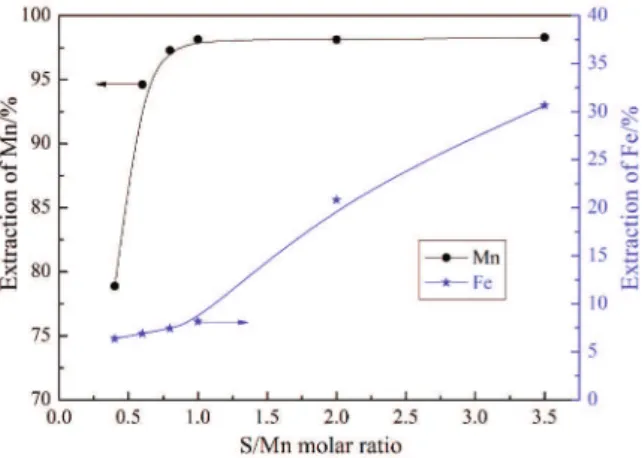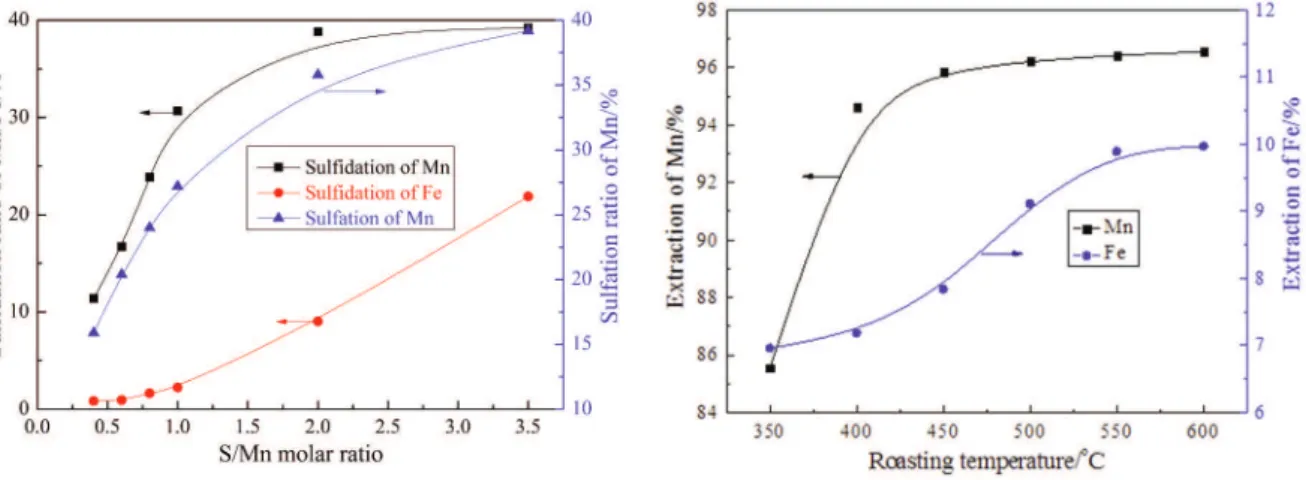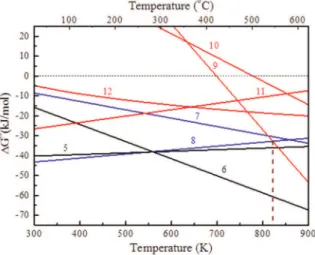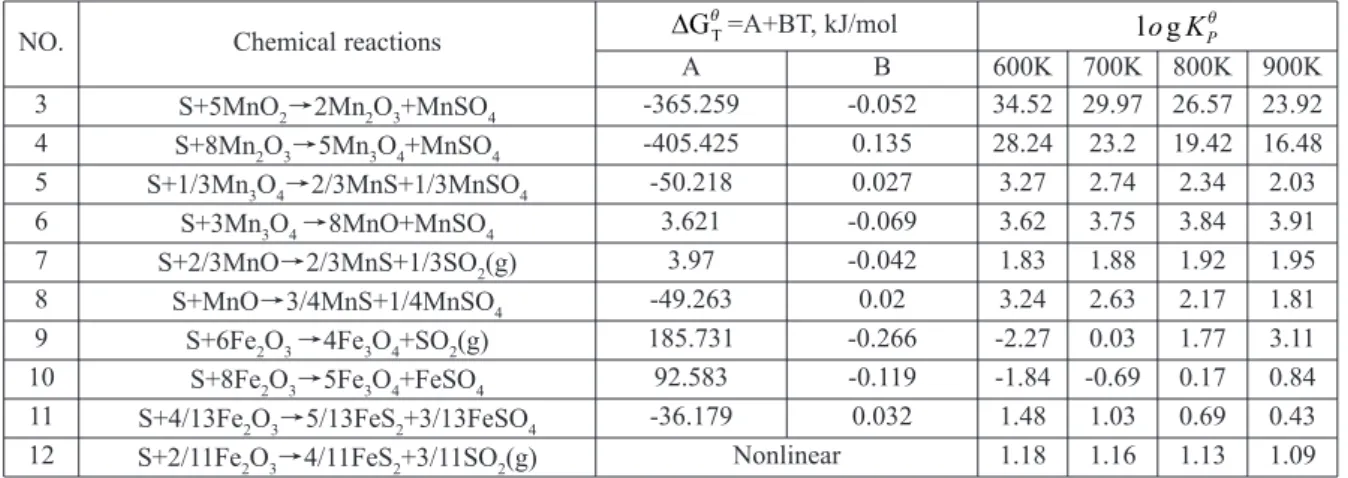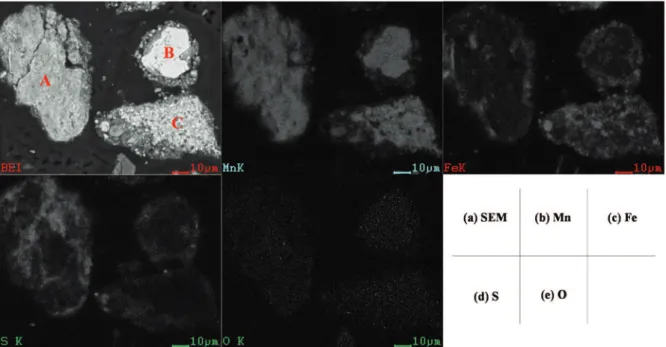REDUCTIVE ROASTING OF IRON-RICH MANGANESE OXIDE ORE WITH
ELEMENTAL SULFUR FOR SELECTIVE MANGANESE EXTRACTION
Z. You, G. Li *, Z. Peng, L. Qin, Y. Zhang, T. Jiang
School of Minerals Processing & Bioengineering, Central South University, Changsha, Hunan, China
(Received 23 February 2015; accepted 23 January 2017) Abstract
It is very important to selectively reduce manganese oxide over iron oxide for extraction of Mn from iron-rich manganese ore. In this study, reductive roasting of an iron-rich manganese oxide ore with elemental sulfur as reductant was investigated. The experimental results demonstrated that manganese dioxide can be selectively reduced with elemental sulfur and extracted via acid leaching, which was largely depended on the sulfur addition. Lower sulfur addition (S/Mn molar ratio<1.0) results in higher selectivity, which is independent of roasting temperature. More than 95% manganese and less than 10% iron were extracted through acid leaching under the roasting conditions of 400-600 oC with S/Mn molar ratio of 0.6. The contents of manganese sulfide and sulfate in the roasted product increased with increasing sulfur addition, while they decreased distinctly at temperatures above 550 oC. The thermodynamic analysis also proved that manganese dioxide is more easily reduced than iron oxide by sulfur at 300-900 K. The phase transformations during reductive roasting revealed that sulfides (MnS and FeS2) were favored at temperatures lower than 550 oC whereas the oxides (MnFe
2O4and Fe3O4) were predominant at higher temperatures. The reduction of iron oxide mainly occurred at large sulfur additions (S/Mn>2.0) and the roasting temperature exerted a significant impact on the phase composition of roasted product.
Keywords: Manganese oxide ore; Sulfur; Reductive roasting; MnSO4
*Corresponding author: liguangh@csu.edu.cn
S e c t i o n B : M e t a l l u r g y
DOI:10.2298/JMMB150223008Y
1. Introduction
Manganese is widely used in the fields of steel production, non-ferrous metallurgy as well as battery industry. In recent years, the rapid development of steel production has consumed large amount of manganese resources, particularly in China [1]. As the superior manganese ores are exhausted gradually, much research has been focused on using low-grade resources as raw material. About 70% of the manganese ore deposits are determined as oxide ore and it is widely distributed around the world. However, it is difficult to utilize this ore in which the insoluble manganese dioxide must be primarily reduced into a form soluble in dilute sulfuric acid or alkaline medium to achieve sufficient manganese extraction [2].
Various reductants have been employed for reducing tetravalent manganese to bivalent manganese oxides that are easier to be leached in dilute acid solution. Manganese dioxide can be reduced in acid solution by metallic iron or iron(II) sulfate [3], pyrite [4], hydrogen peroxide [5], biomass [6], oxalic acid [7] or nitrogeneous reductant [8], etc. Manganese is also capable of being extracted by SO2
leaching [9], electrolysis and bioleaching with various microorganisms [10]. On the other hand, pre-reduction of manganese dioxide by roasting in the presence of reductants may be employed prior to acid leaching. The process of carbothermal reduction followed by acid leaching is considered as the most common approach and coal is used as reductant in the reductive roasting [11, 12]. Although the conventional process is highly efficient, a great deal of pollutants (such as SO2, NOx, dust) will be produced. Worse still,
roasting is generally performed at temperatures over 850 °C which consumes huge amounts of energy. Other reductants reported in the literatures include pyrite [13], SO2[14], ammonium salts ((NH4)2SO4or
NH4Cl) [15], CO [16], CH4 [17], H2 [18], and carbohydrate [19].
Recently, sulfur-based reduction or sulfidation using elemental sulfur as reductant has received increasing attention. The sulfidation of a nickeliferous lateritic ore in the presence of sulfur indicated that the nickel oxide can be selectively sulfidized to a nickel– iron sulfide at 400-550 oC [20]. Similarly, studies on
carbonates were likely converted to sulfides which can be recovered by flotation. A major problem of these technologies is, however, the submicron particle size of sulfides obtained after low temperature sulfidation roasting which usually causes low metal recovery in flotation.
An alternative process of reductive roasting of manganese oxide ore with elemental sulfur prior to acid leaching has also been successfully developed for manganese extraction [25]. This process employs a relatively low roasting temperature which is considered as a cheap reductive method. Acid leaching is appropriate to be applied in extracting manganese due to the formation of sulfate. Furthermore, partially reduced manganese dioxide is validated to be highly reactive in acid/alkaline medium, thus, it is unnecessary to be completely reduced [26].
Although desirable manganese extraction and low iron extraction can be obtained in this process, the reductive priority between manganese and iron oxides, and the phase transformations during roasting have not been investigated [25, 27]. Studying the behavior manganese and iron oxides in detail is of great significance to reveal the reductive roasting process. This paper is aimed to illustrate these issues. The effects of S/Mn molar ratio and roasting temperature on the reduction process were firstly investigated. Then, the thermodynamic behaviors of manganese and iron oxides reduced by elemental sulfur were studied. Finally, the phase and morphology transformation were further investigated by XRD and SEM analysis.
2. Experimental 2.1. Materials
The Mn-bearing sample was obtained from Leping, Jiangxi, China. This kind of ore was originated from sedimentation processes and the ore deposit is being exploited. The chemical composition of the sample by referring to the Chinese standard of chemical analysis method of manganese ore is shown in Table 1. The total Mn grade (TMn) is only 14.30% and TFe is as high as 30.35%, which reveals that this sample is a kind of iron-rich manganese ore. The size distribution of the sample is determined as 100% passing through 74 μm. The XRD pattern is presented in Fig. 1, which indicates that the main manganese mineral is cryptomelane (K2-xMn8O16), goethite
(α-FeO(OH)) and hematite (Fe2O3) are the principal iron
phase. Chemical phase analysis (refer to Section 2.3 for details) was used to measure the quantitative distribution character of manganese in the raw material, and the results reveal that Mn-bearing phases in the sample include 96.9% of manganese dioxide (MnO2), 1.9% of manganese carbonate
(MnCO3) and 1.2% of manganous silicate (MnSiO3). The reductant used in the present work was chemically pure sulfur with purity greater than 99.99%.
2.2. Experimental procedure
The ground manganese ore and sulfur were mixed in various proportions and then put into a stainless steel reactor. The reactor was introduced into an electrically heated muffle furnace which was preheated to a given temperature. The schematic of the furnace was described in the literature [27]. At the completion of roasting for 30 min, the samples were cooled, discharged and prepared for subsequent tests. Acid leaching is used to evaluate the selectivity during reductive roasting. The leaching experiment was carried out in a beaker which was equipped with an agitator. Ten grams of the roasted sample was put into the beaker which contained sulfuric acid solution, and the leaching temperature was adjusted by locating the beaker in a water bath. The acid leaching conditions were fixed as 1 M H2SO4, 25
oC, 10 min,
5 ml/g of liquid-solid ratio and 200 rpm, according to the literature [27]. After leaching, the solution will be filtered to obtain the leachate and the residue. The residue after being dried and the leachate were prepared for subsequent chemical analysis.
Figure 1.XRD pattern of the raw iron-rich manganese ore
Table 1.Main chemical composition of manganese ore/wt.%
TMn TFe SiO2 CaO MgO Al2O3 P S K2O Na2O LOI*
14.3 30.35 18.63 0.22 0.92 2.21 0.28 0.18 2.14 0.12 10.07
2.3. Analytical method
2.3.1. Instrumental analysis
X-ray diffraction analysis was conducted to determine the phase composition of the roasted products. The XRD measurements were made on a diffractometer (RIGAKU D/Max 2500, Japan). A scanning electron microscope equipped with an energy dispersive spectrometer (SEM-EDS, JEOL JSM-6490LV, Japan) was used for microstructure analysis. The sulfur content was determined using a high-frequency infrared ray Carbon-Sulfur analyzer (CS 3000, NCS, China). For evaluation of the manganese balance after leaching, the Mn contents in the leachate were determined by ICP analysis (ICP-OES, Thermo Scientific iCAP 7000 series, America).
2.3.2. Chemical analysis
The total Mn and Fe contents were detected by chemical analysis, as described in detail in the literature [27]. The degrees of manganese and iron sulfidation were determined by a bromine–methanol diagnostic leach, which selectively leaches sulfides and metallic elements while leaving behind corresponding oxides [20, 28]. The sulfation degrees of manganese and iron were evaluated by leaching in aqueous solution, as only manganese and iron sulfates are water-soluble.
The chemical phase of manganese was analyzed according to the following methods [30].
1) Manganese carbonate
A 0.2000 g ore sample was put into a beaker, where 10 g NH4Cl and 50 mL distilled water were added. Then the prepared solution was heated and kept boiling slightly for 60 min, followed by filtration. The manganese content in the form of carbonate was assayed in the filtrate.
2) Manganese dioxide
The residue together with the filter paper obtained from the first step was quenched with 50 ml H2SO3
solution (2 mol/L) for 60 min, then filtrated and washed, the manganese content in the form of high-valence was assayed in the filtrate.
3) Manganese silicate
The manganese content in the form of silicate was assayed in the residue obtained from the second step. Mixed sulfuric-phosphoric acid (mass ratio of 1:1, 50 ml) was used to dissolve the residue by heating and keep boiling for 30 min. The manganese content in the solution was subsequently assayed.
2.3.3. Evaluation index
The retention ratio of sulfur represents the proportion of sulfur retained in roasted product except the unreacted one. The extraction of manganese or iron in sulfuric acid can be calculated as follows to evaluate the selectivity:
where γ is the extraction of Mn or Fe, %; m0and m1 are the weight of roasted product and leached
residue, respectively, g; α is the Mn or Fe grade of roasted product, %; and β is the Mn or Fe grade of leached residue, %.
3. Results and discussion
3.1. Reductive selectivity of Mn and Fe oxides of the iron-rich manganese ore
3.1.1. Effect of S/Mn molar ratio
In order to investigate the effect of S/Mn molar ratio on the extractions of manganese and iron in sulfuric acid, the samples were roasted at 400 o
C for 30 min and the results are shown in Fig. 2. It can be seen that the leaching of manganese is greater than that of iron at various sulfur additions. The manganese extraction increases distinctly at low S/Mn molar ratio and then reaches stable at about 96%. However, the iron extraction increases slightly to about 7% when the S/Mn molar ratio is less than 1.0, and then increases with the sulfur addition. It suggests that manganese dioxide was reduced prior to iron oxide by sulfur as only low-valence manganese oxides are soluble in dilute sulfuric acid solution. With higher sulfur addition, more iron oxide was reduced resulting in rapid increase in iron extraction. Hence, lower sulfur addition contributes to higher selectivity at 400o
C.
Figure 3 shows the sulfur content and retention ratio in roasted product as a function of the initial sulfur addition. The sulfur content increases continuously with increasing sulfur addition, whereas the retention ratio of sulfur exhibits an opposite tendency. The sulfur content appears to be almost linearly proportional to sulfur addition, particularly Figure 2.Effects of S/Mn molar ratio during reduction on the acid leaching of manganese and iron. (Roasting temperature: 400 oC)
γ β
α
= ×
× × (1-m
m ) 100%
when the S/Mn molar ratio is less than 1.0. The retention ratio remains relatively high at about 59% with S/Mn molar ratio of 0.4, and then decreases with the increase of S/Mn molar ratio. The drop in retention ratio suggests that the increased sulfidation at higher sulfur additions may act as a barrier preventing the mass transfer of sulfur from diffusing through the product phase [29]. The remaining sulfur would evaporate which results in lower utilization.
In order to reveal the effect of sulfur addition on the selective reduction of manganese oxide over iron oxide, the sulfidation (sulfide formation) and sulfation (sulfate formation) degrees of manganese and iron in roasted products were studied. The results in Fig. 4 indicate that the sulfidation of Mn increases gradually from 11.4% to 38.8% with the increase of S/Mn molar ratio from 0.4 to 2.0, and then changes slightly. However, iron oxide is not obviously sulfidized until the S/Mn molar ratio is greater than 2.0. Because only manganese (+2) and iron (+2) sulfates are
water-soluble, the sulfation degree of Mn determined by water leaching increases from 15.9% to 39.2% within the S/Mn molar ratio range of 0.4-3.5, whereas that of iron was negligible at all of the sulfur additions.
Although the extraction of Mn is close to 100% while the contents of manganese sulfide and sulfate in the roasted product are much lower than 100%, the existence of manganese sulfide (MnS) also contributes to the relatively high extraction of manganese in sulfuric acid. Manganese sulfide in the roasted product serves as a reducing agent during acid leaching which can be described as follows [25]:
4MnO2+MnS+4H2SO4→5MnSO4+4H2O (1)
4Mn3O4+MnS+12H2SO4→13MnSO4+12H2O (2)
3.1.2. Effect of roasting temperature
The extraction of manganese and iron as a function of roasting temperature is shown in Figs. 5-7. The manganese and iron extractions obtained at different roasting temperatures for 30 min with S/Mn molar ratio of 0.6 are illustrated in Fig. 5. There is a remarkable difference in the extraction of Mn and Fe. The Mn extraction is much higher than the Fe extraction from 350 to 600 o
C. The manganese extraction increases distinctly to higher than 96% when the roasting temperature rises in the range of 350-450 oC. The increasing trend then slows down at
higher temperatures. The relatively low extraction of Fe indicates ineffective reduction of iron oxide due to the priority of reduction of manganese dioxide. The Fe extraction is also observed to change slightly within the roasting temperature range, which demonstrates that the roasting temperature does not play a predominant role in the reducing selectivity of Mn over Fe at low sulfur addition.
The sulfur content and corresponding retention ratio in the roasted product are presented in Fig. 6. It is evident that both indexes decrease gradually with Figure 3.Effects of S/Mn molar ratio on the S indexes in
roasted product. (Roasting temperature: 400 oC)
Figure 4.Effect of sulfur addition on the sulfidation and sulfation of manganese and iron. (Roasting temperature: 400 oC)
increasing the roasting temperature. The maximum sulfur content of 2.9% and retention ratio of 55.9% are attained at 350 oC and they also change slightly
within the temperature range of 350-450 oC. However,
a further increase in roasting temperature exerts a significant impact on the decrease of sulfur indexes. This is because sulfur has a low boiling temperature (about 450 oC), and may sublimate considerably with
increasing roasting temperature. Further, the sulfides should not coexist with the corresponding oxides at higher temperatures [20]. Thus, the sulfur content and retention ratio are decreased.
Figure 7 illustrates the sulfides and sulfates contents in the roasted products. It can be observed that both the manganese sulfide and sulfate change slightly within the temperature range of 350-450 oC.
The sulfidation of manganese begins to decrease when the temperature is increased to 500oC, which
was caused by the sublimation of sulfur as well as the reaction between the sulfides and the corresponding oxides. It suggests that there may be a change in
mechanism at different roasting temperature. The decline in manganese sulfate may be also caused by the inhibition of the reaction between SO2and MnO2 at higher temperatures [27]. In addition, the sulfidation of iron is found to be negligible with a small decrease at 500 oC and iron sulfate (FeSO
4) is
not detected under the experimental conditions.
3.2. Mechanisms on the selective reduction of Mn and Fe with elemental sulfur
3.2.1. Thermodynamics of reductive roasting
The main chemical reactions of manganese/iron oxides reduced by elemental sulfur are shown in Table 2. Their values (plotted in Fig. 8) calculated at specified temperatures under total pressure of 1 atm are also presented in Table 2. The thermodynamic data was obtained from the software FactSage 7.0.
It can be observed that the reactions of Eqs. 3-8 may occur spontaneously at temperatures between 300 K and 900 K. Manganese dioxide is reduced stepwise forming low-valence manganese oxide and sulfate by the reactions of Eqs. 3-6 due to their negative free energy. The reduction of Mn3O4varies
with the temperature (Eqs. 5-6). Higher temperature is beneficial to the formation of MnO and MnSO4, while
MnS and MnSO4 are the main products at lower temperatures. This explains the sulfidation and sulfation of Mn, as well as the sulfur indexes which decrease apparently as the temperature is increased.
Compared to manganese oxides, hematite derived from the dehydration of goethite on heating is also able to be reduced in the presence of sulfur. However, the free energy of reducing hematite is observed to be obviously higher than that of manganese oxides. The priority of reducing hematite is in the order of Eq. 11>Eq. 12>Eq. 9. The equilibrium constants of Eqs. 9-12 are smaller than those of Eqs. 3-6, which indicates less favorable reduction of hematite Figure 6.Effects of roasting temperature on the S indexes
in roasted product. (S/Mn molar ratio: 0.6)
Figure 7.Effects of roasting temperature on the sulfidation and sulfation of manganese and iron. (S/Mn molar ratio: 0.6)
Figure 8.The relationship between Gibbs free energy and temperature.
θ
compared to MnO2, Mn2O3and even Mn3O4. Notably, however, the free energy of Eq. 9 is more negative than that of Eq. 8 at temperatures above 822 K (the intersection of Eqs. 8 and 9). It reveals that Fe2O3
would only be reduced prior to MnO above the temperature. The reduction of hematite to magnetite (Eq. 9) rather than iron sulfide also contributes to the decrease of sulfur content and retention ratio.
According to the above thermodynamic analysis, manganese oxides can be more easily reduced to bivalent compounds than hematite by elemental sulfur. The reductant of sulfur would firstly reduce manganese dioxide and excessive sulfur then reacts with hematite. This is in good agreement with the effect of S/Mn molar ratio on the reductive selectivity between manganese and iron oxides. Lower sulfur addition is proved to have a positive effect on the selective roasting, while roasting temperature plays an important role in the composition of roasted products. Higher temperature is advantageous to the formation of oxides, while the generation of sulfide is favored at lower temperature. Thus, selective reduction and extraction of manganese which leaves iron oxide unreacted, is feasible by adjusting the sulfur addition and roasting temperature.
3.2.2. Phase transformation during reductive roasting
To identify the transformation of manganese and iron phases during reduction with elemental sulfur, X-ray diffraction was performed and the XRD patterns of reduced products obtained under disparate conditions are compared in Fig. 9.
As observed in Fig. 9, the diffraction pattern of product prepared at 400 oC with the S/Mn molar ratio
of 0.6 is quite different from that of raw manganese ore. Cryptomelane (K2-xMn8O16) in the raw ore disappears, whereas manganese sulfide (MnS) is formed. However, no obvious peaks of manganese sulfate can be observed due to its low content.
Goethite (α-FeO(OH)) in the manganese oxide ore
is dehydroxylated and hematite (α-Fe2O3) is formed above 400 oC, as described by the following equation:
2FeOOH→Fe2O3+H2O (13)
As the S/Mn molar ratio is increased to 2.0, more manganese sulfide is generated and the content of hematite is reduced simultaneously. This is attributed to the formation of pyrite at higher sulfur addition. The results are in line with the variations of sulfidation extent and sulfur indexes of roasted products with the sulfur addition (Figs. 3 and 4).
The diffraction pattern obtained at 550 oC with
S/Mn of 0.6 is almost the same as that of 400 oC
except for the appearance of weak magnetite peaks. However, obvious changes can be observed at higher temperatures over 600 °C. Manganese sulfide is not observed at 600 oC, and the peaks of magnetite are
enhanced through either direct reduction via sulfur or
NO. Chemical reactions =A+BT, kJ/mol
A B 600K 700K 800K 900K
3 S+5MnO2→2Mn2O3+MnSO4 -365.259 -0.052 34.52 29.97 26.57 23.92 4 S+8Mn2O3→5Mn3O4+MnSO4 -405.425 0.135 28.24 23.2 19.42 16.48 5 S+1/3Mn3O4→2/3MnS+1/3MnSO4 -50.218 0.027 3.27 2.74 2.34 2.03 6 S+3Mn3O4 →8MnO+MnSO4 3.621 -0.069 3.62 3.75 3.84 3.91 7 S+2/3MnO→2/3MnS+1/3SO2(g) 3.97 -0.042 1.83 1.88 1.92 1.95 8 S+MnO→3/4MnS+1/4MnSO4 -49.263 0.02 3.24 2.63 2.17 1.81 9 S+6Fe2O3 →4Fe3O4+SO2(g) 185.731 -0.266 -2.27 0.03 1.77 3.11 10 S+8Fe2O3→5Fe3O4+FeSO4 92.583 -0.119 -1.84 -0.69 0.17 0.84 11 S+4/13Fe2O3→5/13FeS2+3/13FeSO4 -36.179 0.032 1.48 1.03 0.69 0.43 12 S+2/11Fe2O3→4/11FeS2+3/11SO2(g) Nonlinear 1.18 1.16 1.13 1.09 Table 2.Possible reactions between manganese/iron oxides and elemental sulfur.
θ
GT
∆ θ
l go K P
solid state reaction between hematite and existing pyrite [20]. Although the roasting temperature does not significantly impact on the selective reduction, increasing the temperature over 600 °C is a potential efficient approach to recover iron from the leaching residue as iron mineral is transformed to magnetite.
There is also some evidence of spinel at 600 °C due to the reaction of Eq. 14, whose peaks are similar to magnetite. Manganese monoxide (MnO) may be derived from the reduction of hausmannite (Mn3O4)
by sulfur, or solid state reaction of Eq. 15 whose theoretical temperature when starting reaction is 753 K. Additionally, quartz (SiO2) remains unchanged in the experimental temperature range.
Fe2O3+MnO→MnFe2O4 (14)
MnS+3Mn3O4→10MnO+SO2(g) (15)
The above results reveal that manganese dioxide is selectively reduced by elemental sulfur. Manganese sulfide is generated at temperatures lower than 550
oC, whereas some spinel is formed over 600 oC. Iron
sulfide only exists at S/Mn molar ratio of 2.0, which explains the increased sulfidation degree at higher sulfur addition (Fig. 4). By increasing the roasting temperature to some extent, the sulfides would not coexist thermodynamically with the corresponding oxides. It agrees well with the sulfidation as a function of roasting temperature. The results are also in accordance with the extraction of manganese and iron, and the sulfur indexes (Figs. 5 and 6).
In order to further understand the characteristics of the roasted product, the products treated at 400 o
C with S/Mn of 0.6 were examined by using SEM-EDS
and the results are shown in Fig. 10. From the surface scanning images, manganese distributes almost uniformly in particle A whereas sulfur is more distinct within near-surface parts of the particle and near the cracks. It proves that sulfidation reaction takes place from periphery to the interior of the mineral particles. As the manganese and iron are closely associated in the raw material, the sulfidation of iron on the surface of the particles would inhibit further reduction or sulfidation of inner Mn-bearing minerals, as observed from particles B and C in Fig. 10. The iron sulfide generated on the surface restrains the mass transfer of sulfur. Oxygen exists mainly in the center of the particles, which suggests the sulfidation reaction taking place from periphery to the interior of the mineral particles.
4. Conclusions
Selective reduction of manganese oxide while leaving most of iron oxide unreacted was accomplished in the process of reductive roasting with elemental sulfur. Over 95% Mn and less than 10% Fe were extracted via acid leaching preceded by reductive roasting at 400-600 oC with S/Mn molar
ratio of 0.6. The contents of manganese sulfide and sulfate, as well as the total S content increased gradually with increasing the sulfur addition, while they decreased obviously as the roasting temperature was greater than 550 oC. The experimental results
were confirmed by the thermodynamic analysis which indicated manganese dioxide is more readily reduced than iron oxide by roasting with elemental sulfur as
reductant. Lower sulfur addition is expected to result in better selectivity, and the roasting temperature plays an important impact on the composition of roasted products. At lower roasting temperatures (T< 550 oC) and the S/Mn molar ratio of 0.6, manganese
sulfide is generated. With higher sulfur addition, however, pyrite is formed. At higher temperatures, oxides (MnFe2O4, Fe3O4) become thermodynamically
stable.
Acknowledgements
The authors wish express their thanks to the Program for New Century Excellent Talents in University (NCET-11-0515), the Teachers’ Research Fund of Central South University (2013JSJJ028) for financial support of this research. This work is also financially supported by Co-Innovation Center for Clean and Efficient Utilization of Strategic Metal Mineral Resources.
References
[1] F.F. Wu, H. Zhong, S. Wang, Chinese Manganese Industry, 41(8) (2012) 1443−1447. (in Chinese) [2] A.G. Kholmogorov, A.M. Zhyzhaev, U.S. Kononov,
G.A. Moiseeva, G.L. Pashkov, Hydrometallurgy, 56 (2000) 1−11.
[3] M.S. Bafghi, A. Zakeri, Z. Ghasemi, M. Adeli, Hydrometallurgy, 90 (2007) 207−212.
[4] B.B. Nayak, K.G. Mishra, R.K. Paramguru, J. Appl. Electrochem., 29 (1999) 191−200.
[5] T. Jiang, Y.B. Yang, Z.C. Huang, B. Zhang, G.Z. Qiu, Hydrometallurgy, 72 (2004) 129−138.
[6] D. Hariprasad, B. Dash, M.K. Ghosh, S. Anand, Miner. Eng., 20(14) (2007) 1293−1295.
[7] R.N. Sahoo, P.K. Naik, S.C. Das, Hydrometallurgy, 62 (2001) 157−163.
[8] D. Hariprasad, M. Mohapatra, S. Anand, J. Min. Metall. Sect. B-Metall., 49 (1) B (2013) 97−106. [9] G. Senanayake, Hydrometallurgy, 73 (2004) 215−224. [10] B.P. Xin, B. Chen, N. Duan, C.B. Zhou, Bioresource
Technol., 102(2) (2011) 1683−l687.
[11] N.J. Welham, Int. J. Miner. Process., 67(1-4) (2002) 187−198.
[12] R. Kononov, O. Ostrovski, S. Ganguly, ISIJ Int., 49(8) (2009) 1115−1122.
[13] C. Li, L.H. He, S.Z. Li, Z.S. Wang, Chemistry World, (4) (2000) 66−69. (in Chinese)
[14] Z.X. You, G.H. Li, Y.B. Zhang, Z.W. Peng, T. Jiang, Hydrometallurgy, 156 (2015) 225–231.
[15] P.K. Sahoo, K.S. Rao, Int. J. Miner. Process., 25(1) (1989) 147−152.
[16] H.Q. Zhang, Y.F. Yu, X.S. Lu, C.G. Ding, L. Zhao, Mining and Metallurgical Engineering, 30(4) (2010) 40−44. (in Chinese)
[17] D. Moradkhani, M. Malekzadeh, E. Ahmadi, T. Nonferr. Metal. Soc., 23 (2013) 134−139.
[18] J.M.M. Paixfio, J.C. Amaral, L.E. Memoria, L.R. Freitas, Hydrometallurgy, 39 (1995) 215−222.
[19] Z. Cheng, G.C. Zhu, Y.N. Zhao, Hydrometallurgy, 96 (2009) 176−179.
[20] C.T. Harris, J.G. Peacey, C.A. Pickles, Miner. Eng., 24 (2011) 651–660.
[21] J.M. Wang, Y.H. Wang, S.L. Yu, F.S. Yu, Miner. Eng., 61 (2014) 92−96.
[22] R. Padilla, M. Rodriguez, M.C. Ruiz, Metall. Mater. Trans. B, 34(B) (2003) 15−23.
[23] Y. Li, J.K. Wang, C. Wei, C.X. Liu, J.B. Jiang, F. Wang, Miner. Eng., 23 (2010) 563−566.
[24] Y.X. Zheng, W. Liu, W.Q. Qin, F. Jiao, J.W. Han, K. Yang, H.L. Luo, J. Cent. South Univ., 22 (2015) 1635−1642.
[25] Kh.S. Abou-El-Sherbini, Sep. Purif. Technol., 27 (2002) 67−75.
[26] N. Chandra, S.S. Amritphale, D. Pal, J. Hazard. Mater., 186 (2011) 293−299.
[27] Y.B. Zhang, Z.X. You, G.H. Li, T. Jiang, Hydrometallurgy, 133 (2013) 126–132.
[28] R. Young, Chemical Phase Analysis, John Wiley & Sons, 2011.
[29] P. Bolsaitis, K. Nagata, Metall. Trans. B, 11B (1980) 185−197.

